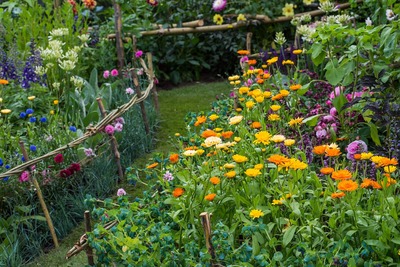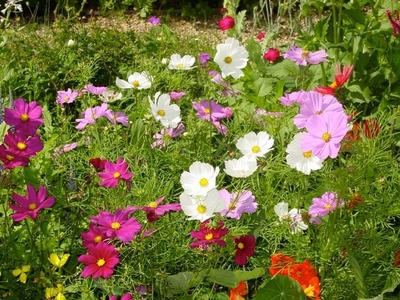Adding flowers to your vegetable garden is more than just about aesthetics. The right flowers can encourage pollination, deter pests, enrich the soil, and attract beneficial insects, creating a balanced ecosystem that can enhance vegetable growth and yield. Here’s a list of the top 10 flowers that can give your vegetable garden a natural boost.
Why Incorporate Flowers in a Vegetable Garden?
Including flowers in a vegetable garden isn’t just about adding color; it’s about creating a healthy, balanced ecosystem. Each flower offers unique benefits that complement your vegetables and help them thrive. Here are some reasons why these flowers make a difference:
- Pollination Support: Many vegetables, especially fruit-bearing plants like tomatoes, cucumbers, and peppers, need pollinators. Flowers like sunflowers, zinnias, and cosmos attract bees, butterflies, and other pollinators, increasing vegetable yields.
- Pest Control: Flowers like marigolds, nasturtiums, and lavender naturally deter pests. They act as natural repellents or trap crops, attracting pests away from valuable crops.
- Soil Health Improvement: Plants like sunflowers and borage have deep roots that draw up nutrients from deep within the soil. When they decompose, they enrich the soil, making it more fertile for future crops.
- Attracting Beneficial Insects: Many flowers attract predatory insects like ladybugs, hoverflies, and parasitic wasps, which naturally control pests by feeding on them. Alyssum, chamomile, and calendula are excellent examples of flowers that attract these helpful allies.
1. Marigolds

Marigolds are a powerhouse in the vegetable garden. Known for their bright, cheerful blooms, marigolds have a scent that repels pests like nematodes, aphids, and whiteflies. They release compounds into the soil that deter these harmful organisms, especially nematodes that damage root systems. Plant marigolds around crops that are vulnerable to pests, such as tomatoes and cucumbers.
- Benefits: Pest deterrent, attracts pollinators, hardy and easy to grow.
2. Nasturtiums

Nasturtiums are a dual-purpose flower that’s both a trap crop and an attractant for beneficial insects. Pests like aphids and flea beetles prefer nasturtiums over other plants, protecting nearby vegetables. Additionally, nasturtiums attract pollinators and predatory insects that feed on garden pests. Plant nasturtiums around cabbage, broccoli, and kale to draw pests away from these crops.
- Benefits: Trap crop, attracts pollinators, edible leaves and flowers.
3. Sunflowers

Sunflowers are excellent for attracting pollinators, especially bees and butterflies. They provide a tall, natural trellis for climbing plants like pole beans and cucumbers. Sunflowers also have a deep root system, which helps break up compacted soil and draws nutrients up from deep layers, benefiting surrounding plants. Plant sunflowers along the garden edge where they won’t shade smaller plants but will provide a support structure for climbers.
- Benefits: Attracts pollinators, provides trellis support, improves soil structure.
4. Lavender

Lavender is a fragrant herb that attracts pollinators and repels pests like moths, fleas, and mosquitoes. Its strong scent confuses harmful insects and can mask the aroma of nearby vegetables, making it harder for pests to locate them. Surround vegetable beds with lavender, especially where you’re growing leafy greens and other pest-prone plants.
- Benefits: Repels pests, attracts pollinators, perennial.
5. Calendula

Calendula, or pot marigold, is known for its bright orange and yellow flowers. It attracts pollinators and beneficial insects such as ladybugs, which feast on aphids. Calendula also has mild antifungal properties, making it a natural disease deterrent in humid climates. Place calendula near tomatoes and squash to help reduce aphid populations.
- Benefits: Attracts beneficial insects, pest deterrent, antifungal properties.
6. Borage

Borage is a favorite among pollinators, especially bees. This annual herb has edible blue flowers that produce abundant nectar. Borage improves soil by adding trace minerals and attracts beneficial insects like hoverflies, which feed on common garden pests. Plant borage around tomato, cucumber, and squash plants to attract pollinators and deter pests.
- Benefits: Attracts bees, improves soil, repels tomato hornworms.
7. Sweet Alyssum

Sweet alyssum is a low-growing flower that forms a ground cover, suppressing weeds and retaining soil moisture. Its delicate white or purple flowers attract predatory insects like ladybugs and lacewings, which eat aphids and other pests. Alyssum’s honey-scented blooms also attract pollinators. Use sweet alyssum as a ground cover around vegetable beds, especially around root vegetables and leafy greens.
- Benefits: Weed suppressant, attracts predatory insects, low-maintenance.
8. Zinnias

Zinnias are vibrant flowers that attract bees, butterflies, and hummingbirds. They’re especially helpful in vegetable gardens where pollinators are essential for fruit-bearing crops. Zinnias also attract ladybugs and parasitic wasps, which help control aphid populations naturally. Plant zinnias near crops that need insect pollination, such as squash, melons, and cucumbers.
- Benefits: Attracts pollinators, attracts beneficial insects.
9. Cosmos

Cosmos flowers are loved by pollinators and beneficial insects, particularly bees, butterflies, and predatory insects. They have an open, daisy-like structure that makes pollen and nectar easily accessible. Cosmos are hardy and thrive in poor soil, making them low-maintenance additions to your garden. Plant cosmos along garden borders to attract pollinators without taking up valuable garden space.
- Benefits: Attracts pollinators, attracts predatory insects, drought-tolerant.
10. Chamomile

Chamomile is a calming herb that has many garden benefits. Known for its tiny daisy-like flowers, chamomile attracts hoverflies and wasps that feed on aphids and other pests. Additionally, it has antifungal and antibacterial properties, which help reduce the risk of plant diseases. Plant chamomile near lettuce, spinach, and other leafy greens to help keep pests at bay.
- Benefits: Attracts predatory insects, antifungal and antibacterial, medicinal uses.
Tips for Growing Flowers in a Vegetable Garden
- Plant Flowers in Clusters: Plant flowers in clusters to make them more visible to pollinators. Grouping flowers with similar colors can also attract specific insects, increasing their effectiveness in pollination and pest control.
- Choose Companion-Friendly Locations: Place flowers strategically near crops that benefit from their presence. For example, marigolds work well near tomatoes, and borage near cucumbers.
- Rotate Flower Planting: Just as with vegetables, rotating flowers can help prevent pest and disease buildup in the soil.
- Avoid Overcrowding: While flowers are beneficial, be mindful of spacing to avoid overcrowding, which can reduce airflow and lead to fungal diseases.
- Mix Annuals and Perennials: Annuals like zinnias and cosmos provide season-long benefits, while perennials like lavender offer long-term pest control and pollination support.

